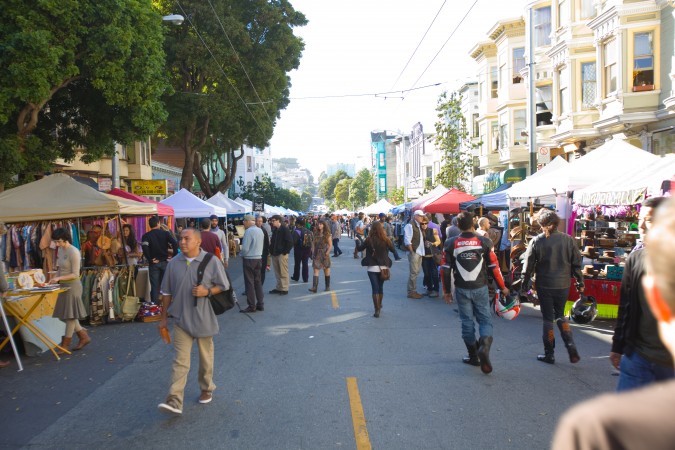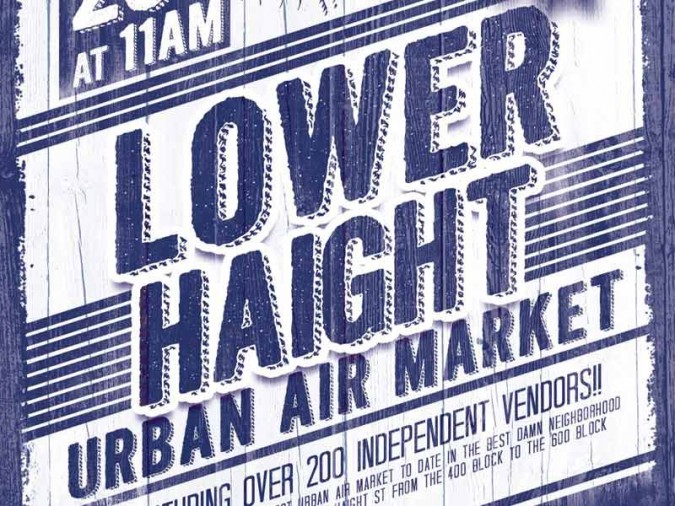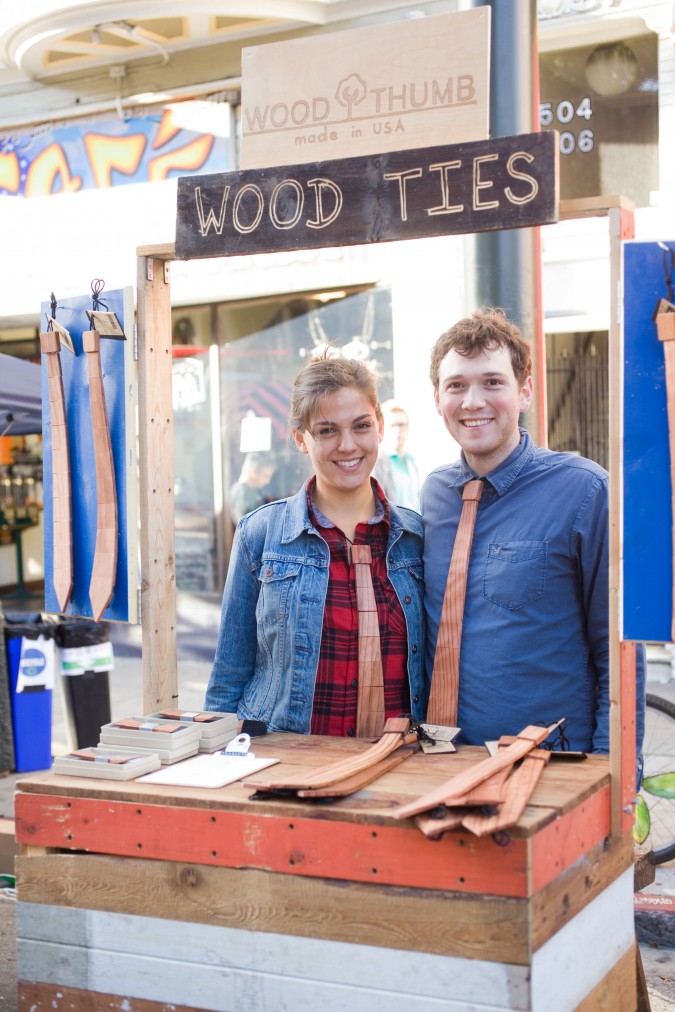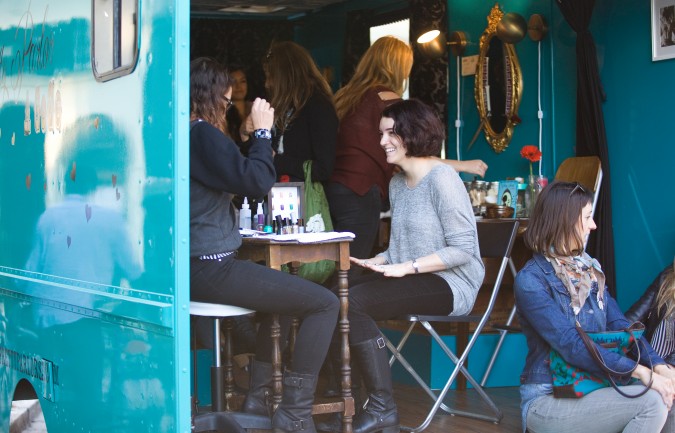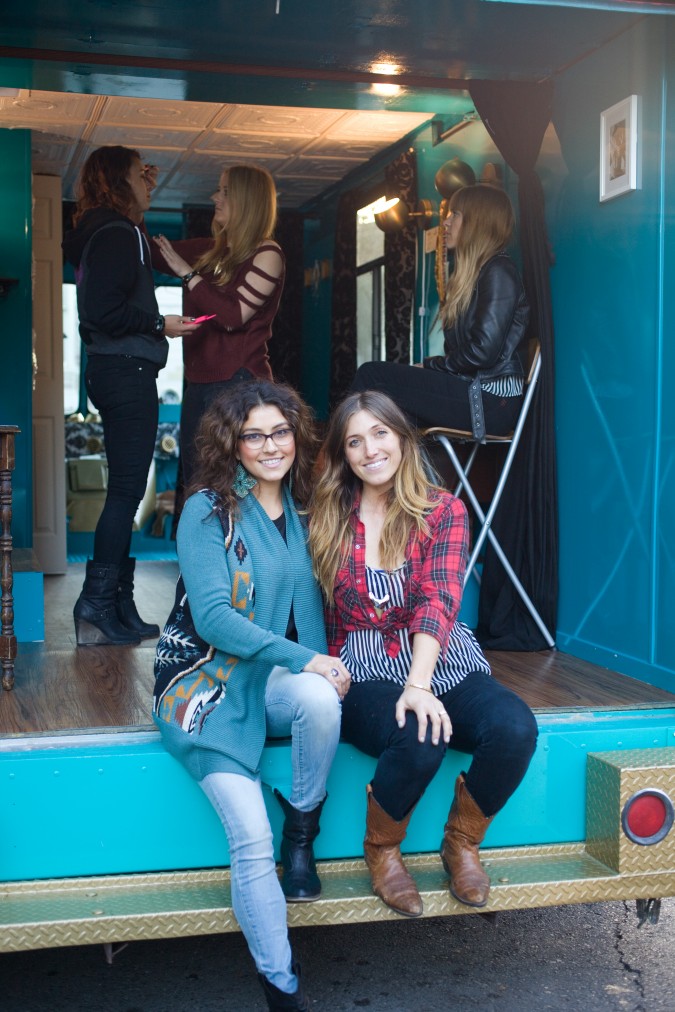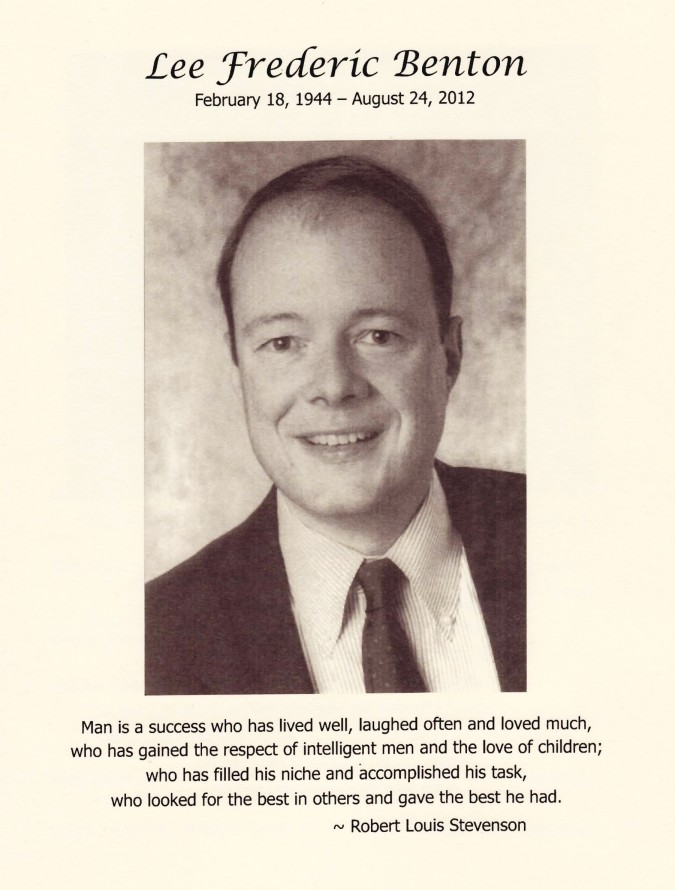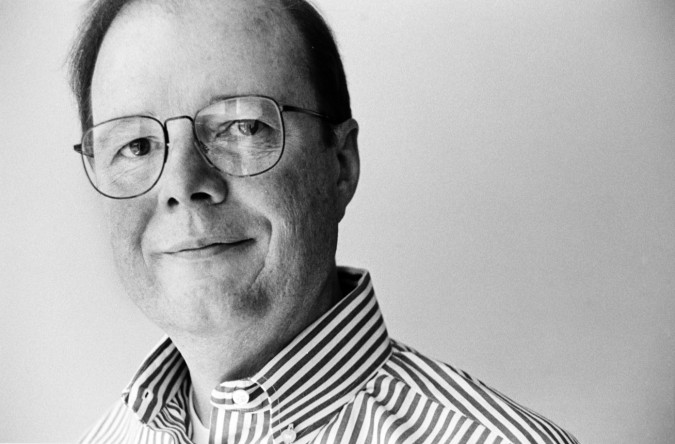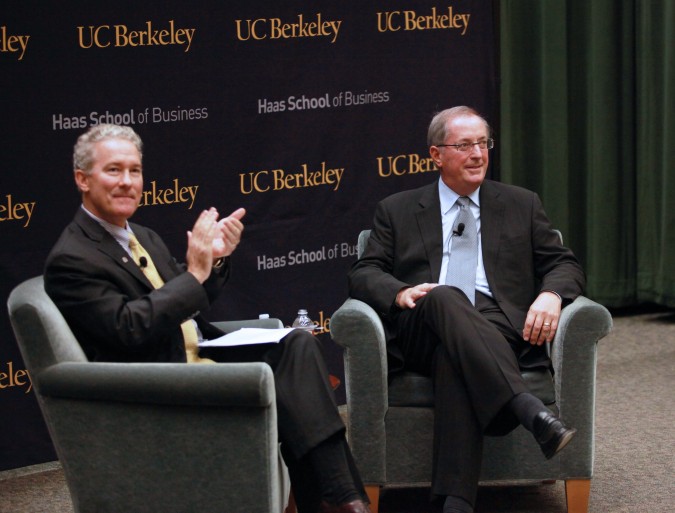Archive for October, 2012
Interviews with 10 entrepreneurs at the Lower Haight Urban Air Market, October 20, 2012, San Francisco, California USA
On Saturday, October 20, 2012, I attended the Lower Haight Urban Air Market. The two most commercially significant blocks, from 400 to 600, of the hip lower Haight street neighborhood of San Francisco, California USA were cleared of cars and closed for this interesting small street fair.
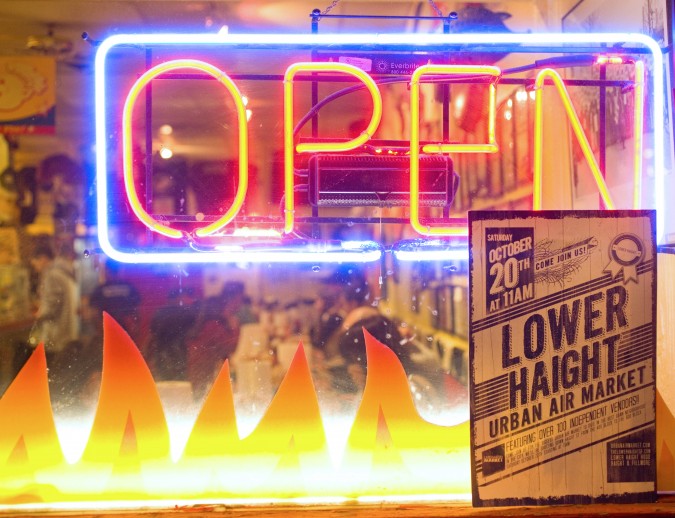
Memphis Minnies Barbeque Joint and Smokehouse, 576 Haight Street, San Francisco, California, October 20, 2012
Here’s a photograph of the poster advertising the Lower Haight Urban Air Market. The window is that of Memphis Minnies Barbeque Joint and Smokehose at 576 Haight Street. I took this picture after the sun went down but before it was completely dark. I haven’t eaten at Memphis Minnies, but I suspect it has quite a following given I see it has 1,127 reviews on Yelp today.
This project must have taken some real effort to plan and execute, because San Francisco’s Municipal Railway, MUNI, runs electric trolley buses on all of Haight Street. This street fair required that non-tethered buses be used instead for the day.
I don’t hang out in the lower Haight much, but Devon Chulick, one of the co-owners of the clothing store and art gallery D-Structure, alerted me to this fair via his store’s Facebook page. Since I’ve met some interesting people though Chulick in the past, I thought it would be smart to attend as a blogger to interview the most interesting entrepreneurs I could find, including the following ten entrepreneurs:
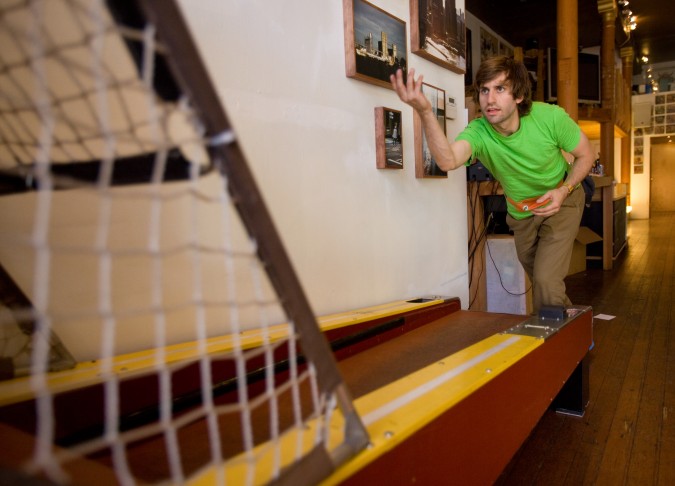
Joey Mucha playing his Skee Ball machine at D-Structure boutique on Haight Street in San Francisco California, October 20, 2012
The first entrepreneur I met was Joey Mucha. He buys used Skee Ball arcade machines, fixes them up, and places them at interesting non-arcade locations. He has a shipping container full of Skee Ball machines, and he knows how to fix them, even to the point of being able to diagnose and replace a bad computer chip on the machine’s scoring computer.
Mucha has one of his machines in Chulick’s D-Structure, and Mucha opened the machine up while I was there, so I could see how the score calculation system works. You can see Mucha playing the D-Structure Skee Ball machine in the photo above.
Amazingly, you can now play Skee Ball on your smart phone.
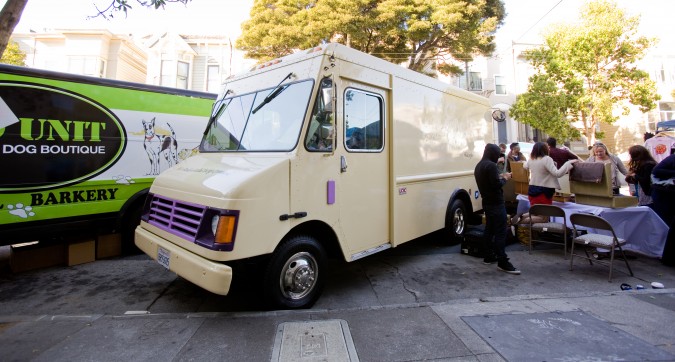
Jasy B clothing boutique inside a converted truck October 20, 2012, Haight Street, San Francisco, California USA
The second entrepreneur I met was Jasmin Baros. Baros introduced me to the concept of a clothing boutique being located in a converted delivery truck. I had never seen such a boutique, or even heard of them, until Saturday.
Baros is an accountant by profession. Her first experiment ten years ago with switching to retail didn’t pan out a after six month run.
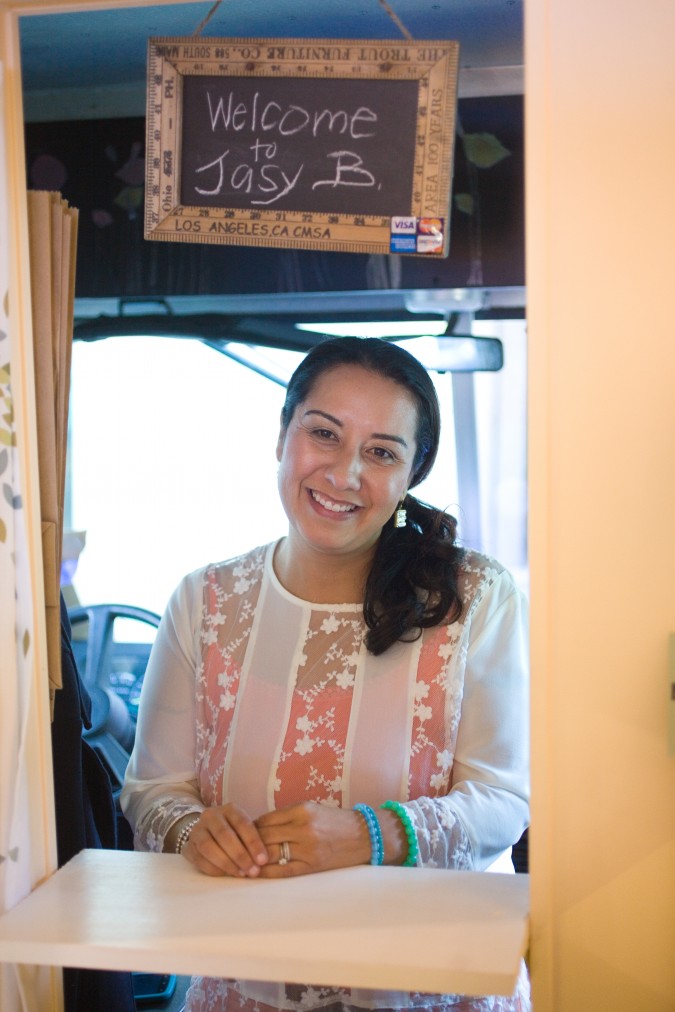
Jasmin Baros owner of http://jasybtruck.com photographed by Kevin Warnock, October 20, 2012, Haight Street Urban Air Market, San Francisco California USA
Her refurbished truck, just six weeks new, is her second attempt at retail, and I think her chances are better than 50/50 for a success. She bought the truck already freshly painted from a photographer for just USD $6,000, and only had to spend $2,000 having her logo painted on the side. It would have likely cost her $6,000 just for the fresh paint if she didn’t find an already freshly painted used truck.
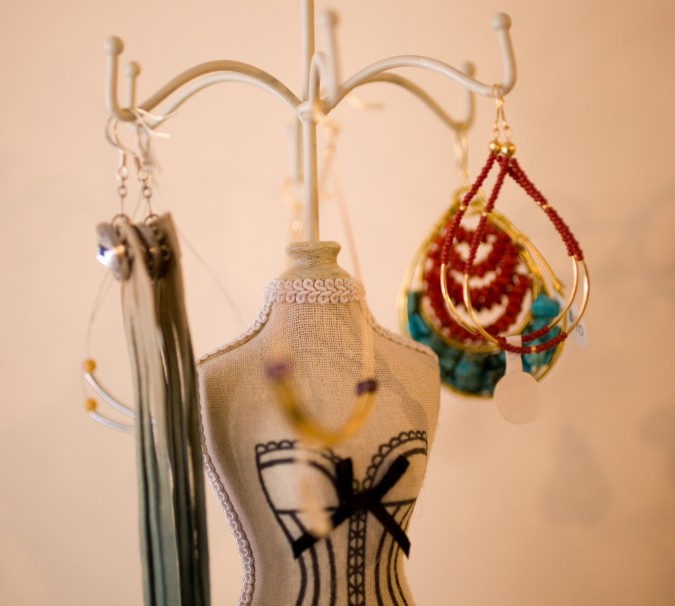
Jewelry for sale on Jasy B clothing boutique truck at Lower Haight Urban Air Market, October 20, 2012, San Francisco, California USA
Baros’ total cost to get into business she told me came to $25,000 — likely a fraction what it would cost to open a traditional retail boutique in leased store front space.
The truck — officially named the Jasy B Truck — is cute and inviting. The ceiling is pressed tin like you’d see in a vintage building. There is wainscoting on the walls. There is directional spot lighting. The colors are right. There’s a dedicated staircase with rails at the rear, where the door rolls up like a garage door. When the truck is parked at a 45% angle relative to the sidewalk, customers can just climb on board, in a way that feels natural and welcoming.
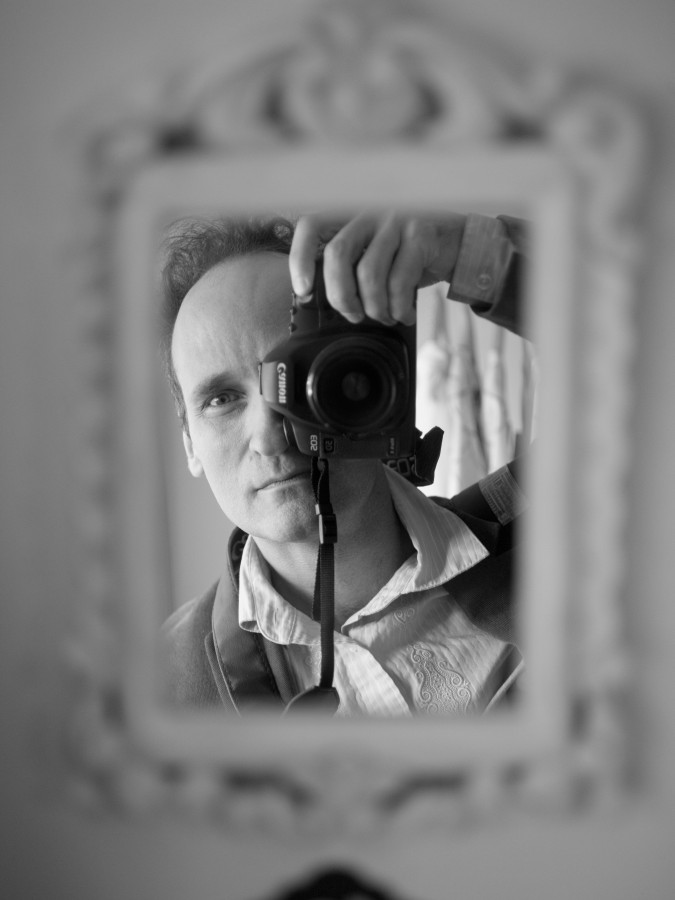
Kevin Warnock self portrait inside Jasy B truck clothing boutique, October 20, 2012, Lower Haight Urban Air Market, San Francisco, California USA
The Jasy B boutique on wheels had a wall mirror next to its jewelry display. I caught a glimpse of myself in this mirror, and since the mirror was small, it neatly framed my head. I snapped a picture with my Canon 5D Mark II digital camera I used to take all the photographs that illustrate this post. Note that I uploaded the pictures at full camera resolution. Click on them twice in delayed succession to see the full size versions, which are 21 megapixels.

Sandra Kathleen Jewelry for sale at Lower Haight Urban Air Market, October 20, 2012, San Francisco, California USA
The third entrepreneur I met was Sandra Bowling, owner of Sandra Kathleen Jewelry. Bowling makes the jewelry. I asked permission to take the above photograph. Bowling gave permission and thanked me for asking permission. She said one woman particularly irritated her by taking pictures without asking, and when confronted, the photographer said she was going to send the pictures to a friend or relative (I can’t recall which) that also made jewelry for profit — to copy and then sell! I presume these designs are not patented, but still, I can see it being annoying having people taking pictures with the express intent of taking your work to profit from it.
Bowling had her jewelry nicely displayed, and I loved the light as shown in my picture above. The brighter spot of light in the lower right was from light bouncing off the hand mirror she had on the table.
Sadly, I forgot to photograph Sandra Bowling.
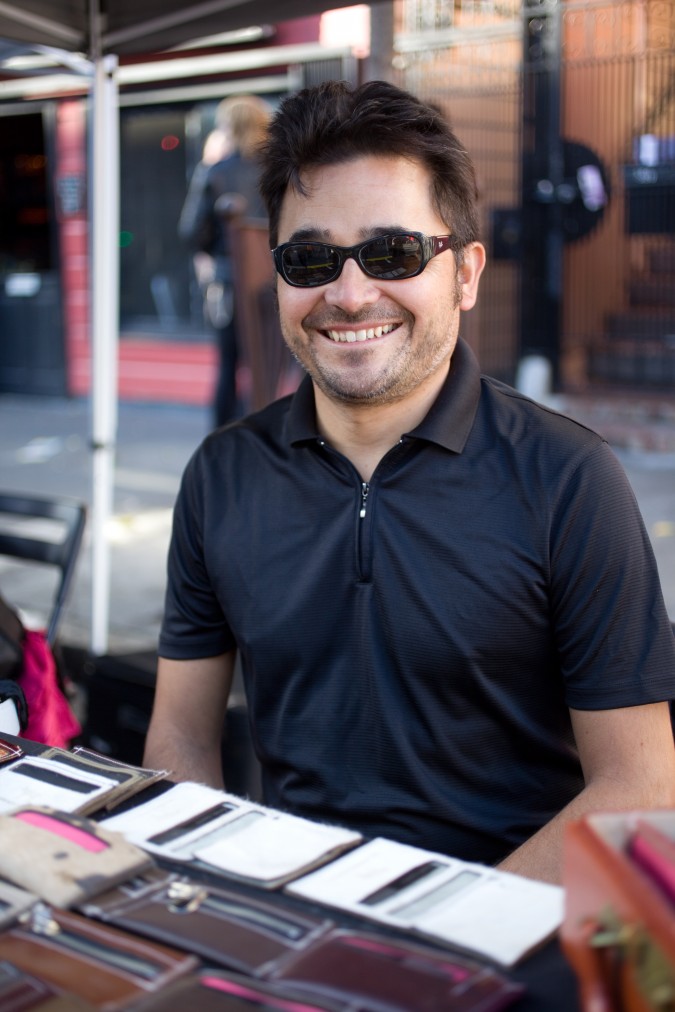
Angel Cantu founder of Halo Bender Design, a maker of upcycled leather wallets made from furniture leather samples, October 20, 2012, Lower Haight Urban Air Market, San Francisco, California USA
The fourth entrepreneur I met was Angel Cantu, above, founder of Halo Bender Design.
Halo Bender Design makes wallets for men from the leather swatches furniture stores have on hand to help buyers decide what leather to buy for custom ordered chairs and sofas. Cantu discovered that stores replace their swatch books from time to time, and when they do, they discard the old books. Cantu has learned that he can rescue the leather from landfill by giving the proprietor a few wallets he made from earlier swatch books. Since his materials cost is so low — thread and his time, this is a great exchange. The swatches he showed me looked brand new, and the wallets looked fresh and brand new as well, with no hint that their leather was perhaps already years old.

Wallets made by Halo Bender Design from furniture leather samples October 20, 2012, at Lower Haight Urban Air Market, San Francisco, California USA
Cantu cut the first wallets by hand with scissors. Then, he joined TechShop, a well equipped workshop that rents access to tools like a health club rents access to exercise machines. TechShop has a laser cutter to replace scissors, and industrial sewing machines capable of stitching leather. TechShop has spawned many small businesses, including DoDo Case, which makes an Apple iPad case that looks like a leather hard cover book. Current United States President Barack Obama carries his iPad in a DoDo Case brand case.
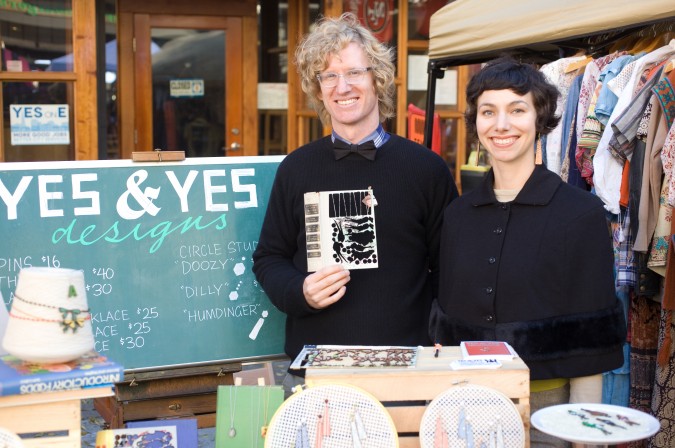
Laura Bruland the founder of Yes and Yes Designs with her boyfriend Julien Shields that works with her in the business, October 20, 2012, San Francisco, California USA
The fifth entrepreneur I met was Laura Bruland, founder of Yes & Yes Designs.
Yes & Yes is another TechShop success story, and she’s featured on their website.
Yes & Yes makes jewelry from old hard cover book covers. Bruland uses TechShop’s laser cutter to slice through the canvas and cardboard book covers in a way that would be nearly impossible with a jig saw or a Xacto knife.
In the picture above of Bruland with her boyfriend Julien Shields you can see Shields holding a book cover that has had over two dozen pieces of jewelry cut from it. The row of trapezoids on top became earrings, in the style you see Bruland wearing in the same picture.

Pins made from the covers of old books by Yes and Yes Designs, over rice, October 20, 2012, San Francisco, California USA
Many of Bruland’s designs feature the silhouettes of stylish women — Bruland confided that the designs themselves are vintage, derived from old dress making patterns. The pins above are examples of these designs. Look at how typography plays a part of her designs.
Like the upcycled wallets made by Angel Cantu, Bruland’s cost of materials is extremely low. She laser cuts out of date and falling apart books of nominal value as books. I suspect she pays little or nothing for most of the books.
I saw customers buying Bruland’s products, and saying nice things about them while doing so, something I didn’t happen to catch with any of the other artists at Saturday’s fair.
The sixth entrepreneur I met was Chris Steinrueck, co-founder of Wood Thumb, a maker of men’s ties and bow ties, among other products.
Wood Thumb recycles redwood it receives for free from Recology, the company that picks up the trash from homes and businesses in San Francisco. Recology sifts through the trash it picks up and hands the redwood planks it finds to Wood Thumb, which then planes and mills the ties into shape. The ties are cut on a ShopBot CNC router.
I love the upcycling and recycling demonstrated at this fair.
Wood Thumb started out at and still does some work at TechShop, like Yes & Yes Designs and Halo Bender Design, also profiled in this post.
The ties are made from redwood because redwood is attractive and particularly because it is light in weight. Chris, who runs the company with his co-founder brother David Steinrueck, said people can feel the difference in weight between redwood and other attractive wood, and prefer the light weight redwood. Conveniently, Wood Thumb ties are rot resistant, in case you forget your tie in the woods, unlike silk or wool ties.
Wood Thumb appears to be doing well, selling thousands of ties per month as of the end of 2011.
I photographed Chris with his girlfriend Rebecca Carrillo at their booth, also made from reclaimed wood.
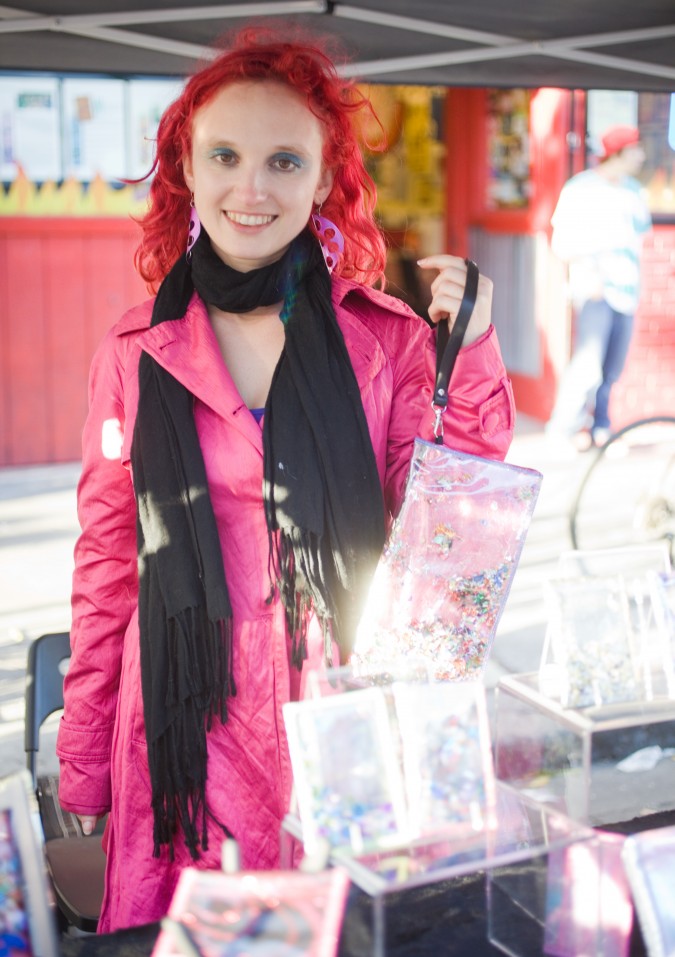
Sarah Boll owner of Glitter Disaster at Lower Haight Urban Air Market, October 20, 2012. Photograph by Kevin Warnock.
The seventh entrepreneur I met was Sarah Boll, who was the most interestingly dressed, with exceptionally red hair, vivid glittery blue eye shadow, a magenta jacket and wild black and white stretch pants she personally sewed. It was a look that is completely consistent with her product — glittery purses, clutches and related accessories. This was Boll’s first time selling at a street fair.
Her company name is Glitter Disaster — a name I really like.
The glitter you see in the clear vinyl is sandwiched between two layers, where it’s free to slide around like snow in a snow globe. The glitter never touches what you put into her clutches and purses. The random and ever changing glitter display catches your eye, and I think these products were the most inspired and unusual of everything I saw on Saturday.
Boll has an online store on Etsy, as well as a Facebook page and a Tumblr account.
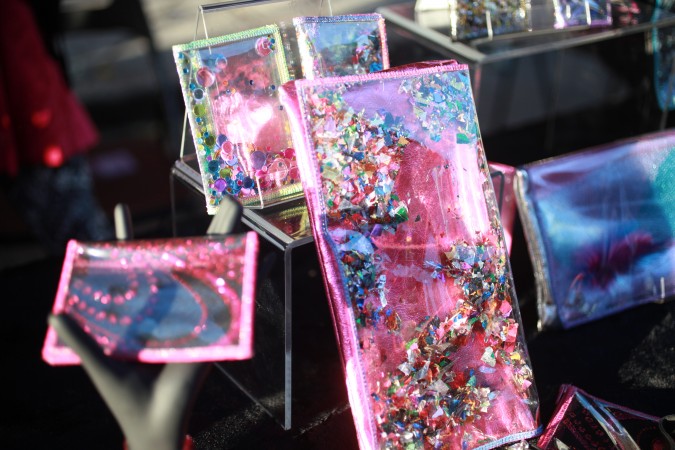
Glamorous accessories for sparkle connoisseurs by Glitter Disaster, October 20, 2012, Lower Haight Urban Air Market, San Francisco, California USA
The vinyl sheets are sewn not with a sewing machine but with a serger, called overlock machines outside of North America for the overlock stitches they create. If you look inside some of your clothes, you will see overlock seams. A serger is a fascinating machine. The overlock seam is not one thread but multiple threads, from separate spools. This means each thread can be a different color, a feature you can see Boll used to create interest with her pieces, since she uses the overlock seams as a visible design element.
I learned about the serger several weeks ago when I was looking into what I would need to sew my own clothes. I took sewing class at Lab School, and I made quilts when I was 12 years old. I want to make some really crazy outfits I can’t find in stores. That’s when I learned I would need a sewing machine and a serger machine. I have since decided to just wait until my next trip to Shanghai and have my clothes made in the world famous Bund fabric market, which will be more productive and more fascinating, because that stupendous fabric market has so many more fabrics than you can buy in the San Francisco Bay Area.
The eighth and ninth entrepreneurs I met were Misty Briglia and Sarah LaShelle, co-founders of Pretty Parlor beauty boutique on wheels. The Pretty Parlor is also built inside a retired delivery truck, like the Jasy B Truck. The beauty business is tightly regulated, unlike the retail clothing business. Thus, the Pretty Parlor truck has a bathroom complete with running water in a charming old world porcelain sink. There’s is room for a wheelchair to move around on board. A wheelchair ramp to board is in the works. I wonder if they can find a suitable aluminum ramp at a salvage yard that dismantles U-Haul trucks — those ramps are really well made.
In the photograph above, the woman in the gray sweater seated had just have her fingernails painted with intricate designs — a different design on each finger. I introduced myself to her and she let me see the results, which she really liked. She gave me permission to include her on this blog. The manicurist Mia Rubie, on the left, had her manicurist license out for display, just like you would see in a fixed location shop. I loved the antique furniture throughout the truck.
In the photograph above the founders Briglia and LaShelleare are sitting on the rear step of the truck. In the background, from let to right, are:
- Marie Rubie — Nail Artist
- Marla Kay — Esthetician
- Katie Stosic — Stylist and Receptionist
All of the trucks had generators chained outside sitting on the pavement. But I saw no heavy electrical requirement in any of the trucks. Since the trucks are only parked for the day, I think they all could switch to LED lighting and power themselves from a dedicated ‘house’ battery bank like those in recreational vehicles and bus conversions that charges from the vehicle alternator while driving. The generators are noisy and unnecessary. From what I could tell, none of the trucks contemplate air conditioning the sales floor while parked, but that’s the only reason for a large generator like the ones I saw.

Products for sale at Pretty Parlor beauty boutique on wheels, October 20, 2012, San Francisco, California USA
I recommend adding a solar panel to the roof to keep the batteries charged while the vehicles are in storage, and also to be able to boast that the stores are in part ‘powered by the sun.’ Solar panels are very affordable these days.
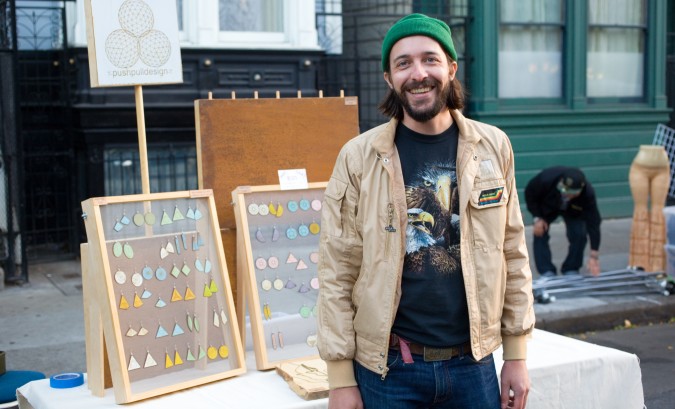
Aaron Bray, owner of PushPullArtDesign.com, October 20, 2012, Lower Haight Urban Air Market, San Francisco, California USA
The tenth and last entrepreneur I met was Aaron Bray, owner of Push Pull Art Design. Bray was at the fair selling his brand new but vintage appearing earrings and pendants.
He cuts the designs from steel with tin snips, and then flattens the cut edges with weights. He then treats the metal to give it a rich aged patina, rust I believe, that makes it resemble copper. I don’t know how Bray paints the pieces, and I could find no description on his website about how they are made. In fact, I could find almost no information about Bray online, and in particular, I could not find any pictures of him. I had Bray’s full cooperation to take the picture you see of him here.
I love Bray’s work, but I don’t understand why he is keeping such a low, low profile online. He should examine how Sarah Boll is using the Internet to promote her art. Bray’s online store is one example of how his low profile is hurting his finances. He sells only his discontinued work on his online store, but there are no ‘buy now’ or ‘add to cart’ buttons to be found. The price is a hyperlink, and if you click that you are taken to PayPal where you can buy that item. But that’s is expecting far too much from people to start clicking links looking for a way to buy. There needs to be a buy button on every item for sale, without exception.

Pendants by http://pushpullartdesign.com, October 20, 2012, Lower Haight Urban Air Market, San Francisco, California USA
The site is so sparse that it’s off putting. I can’t read Bray’s biography or see what he looks like. I can’t learn his phone number. I can’t determine what city, state or country he lives in, except by inferring based on the shows he notes he will attend. Even then, the list is heavy on abbreviations like SF for San Francisco, California. Buyers from other parts of the world may not know what SF means. I can’t learn what stores carry his products. I can’t see his products worn by people. I can’t even learn what the products are made from or how big they are, as there is no reliable size reference in any of the pictures.
Bray has the most subtle, artistic and lovely product of any that I have reviewed here, and I offer the above criticism in the hope that he will make simple changes that I predict will measurably increase his revenues and profits. Here’s one final piece of advice: Add your products to your Etsy store, which currently has zero products for sale. From what I have heard, Etsy really works.
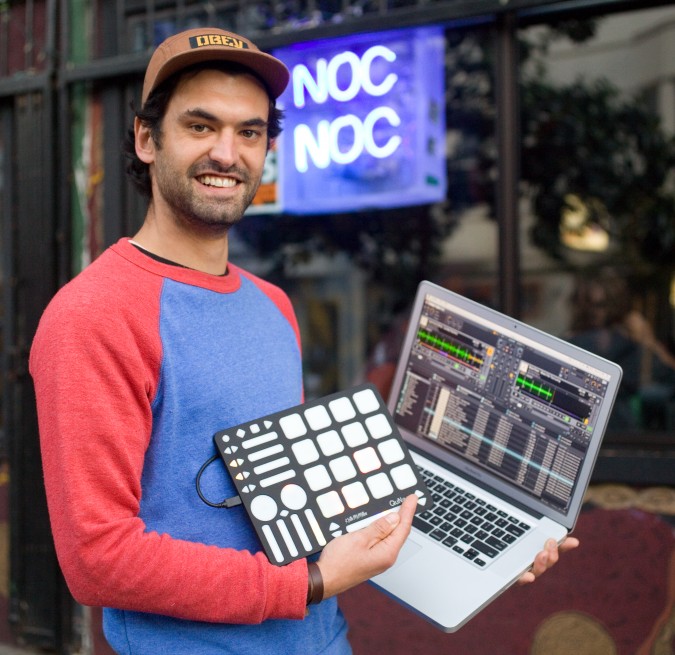
Matt Hettich is the Product Specialist / Artist Relations person at Keith McMillen Instruments, October 20, 2012. Photographed outside Noc Noc bar at 557 Haight Street, San Francisco, California USA.
The last person I met was Matt Hettich. He’s not technically an entrepreneur because he is not a founder of the company whose product he was pitching. But his product is interesting, and his approach to promoting it is also interesting, so I have included him in this post.
Hettich’s title is Product Specialist/Artist Relations. The company he works for is Keith McMillen Instruments. This company didn’t have a booth at the fair. I met Hettich as the fair was winding down, when I walked into the legendary bar Noc Noc that’s been in the same spot on lower Haight Street for decades. The decor hasn’t changed in decades — still the crazy handmade furniture and bar, which is holding up quite well considering the flow of hard living hipsters over the decades.

QuNeo 3D Pad Controller by Keith McMillen Instruments at Noc Noc bar on Haight Street, San Francisco, October 20, 2012
I met Hettich almost immediately because he was showing off the eye catching and colorful QuNeo 3D Pad Controller seen in the pictures above and below. This is MIDI controller for digital musicians and disc jockeys. The buttons on this controller are not labeled because they are mappable by software to whatever you want them to control. The buttons sense where you touch them and how hard you press, which for sounds like drum machines can be very valuable and can help musicians be more expressive.
I am not a musician, but Hettich did a great job explaining the device and why I would want one if I were a musician.

QuNeo 3D Pad Controller by Keith McMillen Instruments in use, October 20 2012, Noc Noc bar, San Francisco, California USA
Company founder Keith McMillen is a legend in the instrument business. One of the company’s customers was sitting with Hettich, and the customer compared McMillen to Robert Moog and Tom Oberheim, and said McMillen is in the same league. This stature probably explains why when his company ran a Kickstarter campaign to raise USD $15,000 he raised over ten times that amount.
The QuNeo costs just USD $249 — less than I guessed.

Modify Watches brand watches for sale at D-Structure at Lower Haight Urban Air Market, October 20, 2012, San Francisco, California USA
Here’s a pretty picture of some colorful silicone rubber wrist watches from Modify Watches, a brand of Modify Industries, Inc. I took this picture outside of D-Structure, where Chulick had a table of wares for sale. D-Structure carries Modify Watches at their store and online.
My friend Aaron Schwartz founded and runs Modify, and I’ve written about his products on this blog before. Schwartz has allowed me to borrow some of his products to photograph being worn by some of the models I photograph.
Schwartz’s company is a on a roll — his products were featured on the very popular United States television show The Today Show on October 3, 2012.
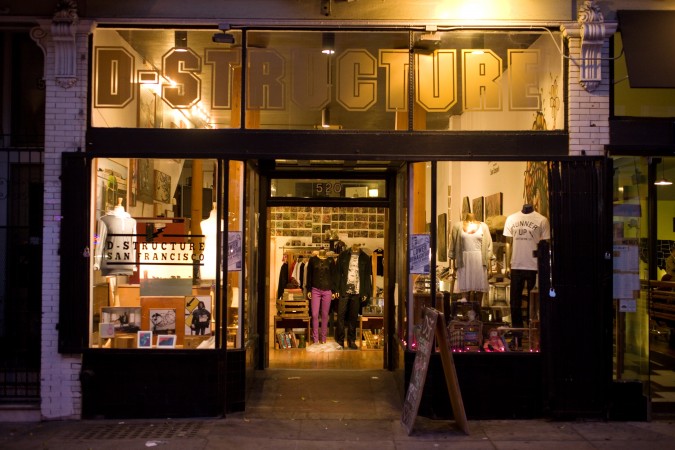
Magic Hour photograph of D Structure clothing boutique and art gallery, 520 Haight Street, San Francisco, California, October 20, 2012
After the fair ended, I took this picture of Devon Chulick’s D-Structure art gallery and boutique, just as the sun was going down. I thought the ‘magic hour’ light was flattering.

Class C motorhome belt buckle for sale by Staghound Belts at Lower Haight Urban Air Market, October 20, 2012
Finally, Staghound Belts had a booth where they sold new belts for men. They also had a collection of vintage belt buckles, including this buckle showing a Class C motorhome on a Ford van chassis. This made me think of George Lehrer, a blogger I’ve read for years. Lehrer for a decade now has lived full time in his Class-C motorhome he has named Ms. Tioga, after the brand name given by its manufacturer. He writes several times a day, and makes about USD $1,000 a month in revenue from Google Ad Words, which supplements his US Social Security retirement checks. I suspect Lehrer would like to have this buckle, and I further suspect that Staghound Belts will have it for sale for some time, as I doubt there is much demand for such a unique item.
It’s likely that Staghound made the belts they were selling, and I should have asked more questions so that I could have written about the founder as an entrepreneur. Next time I will.
[November 27, 2012 — I updated this post to name Julien Shields. The original version of this post referred to him as Laura Bruland’s boyfriend.]
Memorial service for Lee Frederic Benton, October 6, 2012
My birthday was yesterday, October 6, 2012.
I will long remember this birthday because I attended the memorial service for Lee Frederic Benton, held at Holy Trinity Church, 330 Ravenswood Avenue, Menlo Park, California, USA.
Benton was born February 18, 1944 and passed away unexpectedly August 24, 2012.
I did not know Mr. Benton well, but he played a major part in my life. I was able in 2007 to tell him the facts that lead to this conclusion, but, sadly, I don’t believe I thanked him for his pivotal contribution to my success in life. Thank you Lee Benton.
In about 1991 I went to the offices of Analytic Legal Programs, Inc., founded by Eric Little. Analytic Legal Programs made a document assembly software program called WorkForm. At the time, I worked at Cooley, LLP, then named Cooley Godward Castro Huddleson & Tatum. Cooley had purchased a firm wide license for WorkForm, and had asked me to lead the project. Associate attorney Jeff Zimman was to program the first set of documents, a set of 17 documents to incorporate a company in California.
Since neither of us knew the WorkForm software, we both attended a several day training session at the offices of Analytic Legal Programs in Palo Alto, California USA.
Zimman left a voice mail for Benton during our training, and the subject was Zimman’s compensation at Cooley. From that I have guessed Benton supervised Zimman, and gave Zimman his assignments. I have further guessed that Benton authorized Zimman to spend the hundreds of non-billable hours that he would eventually dedicate to the document assembly project. Without Zimman, there would have been no document assembly project, because Zimman was the only attorney at Cooley that showed any interest in document assembly back then. Without Benton letting Zimman stop billing hours to clients for a time, there also would have been no document assembly at Cooley. As a result, without Benton, I would have never become an expert at document assembly, and I would thus have not started Hotpaper.com, Inc., the first Internet document assembly platform, in 1995. Had I not started Hotpaper, I would not have sold it in 2000, and I would not have been able to buy the house I am typing this post in, or to live my life I treasure so much that I write about on this blog.
Starting an Internet company that gets acquired is very difficult. I needed every advantage along the way to get to where I am today, and Lee Benton gave me a huge advantage. He freed up hundreds of hours of time of a rising star attorney, which ended up launching my career in high technology. I simply don’t think I would have gotten into the Internet business had it not been for Lee Benton and Jeff Zimman.
When I was at Cooley, Benton had not yet led the entire firm, but I knew that he would, because Helen Gaffney, since passed, told me so. Gaffney ran the firm’s Information Technology infrastructure at the time she said this, about half a decade before Benton became Managing Partner, the title the firm then used for its top leader. The firm now uses the title CEO for its top leader, and I learned yesterday that Cooley’s current CEO Joe Conroy, joined Cooley while Benton was Managing Partner, and that Conroy greatly admired Benton. Conroy attended Benton’s memorial yesterday, but I did not see him.
Lee Benton’s memorial service was very touching to me. I recognized some of the attorneys that were at Cooley when I left in 1994, including Frederick Baron, Pam Martinson, Alan Mendelson, Gordon Atkinson, Kenn Geurnsey, Paul Renne, James Gaither, Craig Dauchy and my own current attorney Eric Jensen. That this group attended was amazing to me, because I actually received material help on my project in the 1990s from Baron, Martinson, Mendelson, Guernsey, Renne and Jensen. I hadn’t seen Martinson, Dauchy, Atkinson or Gaither since 1994, but I recognized all of them, and they appeared to recognize and remember me when I greeted them. Sadly, Martinson and Mendelson left before I got to say hello to them. I most recently saw Mendelson by chance at Nordstrom in 2008 when I was trying on tuxedos for my wedding.
My friend Tom Kintner was also there, and I learned Kintner worked with Benton and others on the USD $621 book Venture Capital & Public Offering Negotiation. ‘This book is the leading authority on the legal aspects of venture capital funds and of private financing and initial public offerings for technology companies,’ per Cooley’s website. I have known Kintner for over a decade, and I never knew he knew Lee Benton until yesterday.
When I said hello to Paul Renne, I had the great pleasure of meeting his wife, former San Francisco City Attorney Louise Renne.
Benton was revered when I was at Cooley, and although I only spoke with him perhaps half a dozen times in the five years I worked at Cooley, I always knew he was extremely influential. I once had to modify the California Incorporation document set to incorporate his changes, and I vividly remember thinking at the time that they were the most impressive set of edits I had yet seen from any attorney. Even though I am not and have never been an attorney, I had by then developed an ability to identify precise and impressive edits, and Benton’s were outstanding. His dozens of edits made the documents more conclusive without being stern.
Frederick Baron spoke at the memorial. His written remarks were poignant and lovely — so much so that I suggested he post them online for posterity. If he finds this post and thinks this is a suitable place for his remarks to live on, I invite him to forward them to me for incorporation into this post, which I am happy to revise.
One of the stories Baron relayed was so sweet that I am going to relay it here.
Baron told the story of how he arrived at Cooley. He moved to the San Francisco Bay Area and knew of Lee Benton’s stature. He heard Cooley had just opened an office in Palo Alto, its first branch office. The firm was founded in San Francisco. Lee Benton was part of the first group of Cooley attorneys that opened the Palo Alto office. Baron applied to Cooley and got an interview with Benton himself. The story takes a charming turn when Baron told us yesterday that his son, age 4 at the time, rode in a car pool to school starting the day before Baron’s interview with Benton. Using more descriptive language than I will here, Baron described his 4 year old son as a boisterous handful. Baron was alarmed when he learned the night before his big interview with Benton that the driver of his child’s car pool was Lee Benton himself.
As you can guess, the interview went well and Baron was hired despite his fears that his rambunctious son might have harmed his chances. Frederick Baron went on to lead a department for decades.
Baron and Benton and their wives all became dear friends.
One of Lee Benton’s clients, Bob Plaschke, also spoke. He told a series of stories that elicited hearty laughs from the audience. He also spoke affectionately about Benton’s laugh, which he described as infectious, distinctive and highly memorable. I never heard Benton laugh because in total I probably spent no more than 30 minutes speaking with him, the most recent 10 minutes at a party at Cooley in 2007, when I got to have a very nice conversation with him despite the absence of laughing.
Plaschke told a great story about when one of his companies was doing a closing for a transaction. The closing happened on a weekend, and Benton dropped by the Cooley office where other attorneys were completing the work. However, Benton wanted to pitch in and help, and he asked a young associate how he could contribute. Plaschke said this young female associate tried meekly to decline Benton’s offer, but Benton persisted. Finally, using her hands that were trembling with fear, she handed a document she had written to Benton and asked him if he would review it for her. Benton enthusiastically attacked the document with his red pen, and when complete, there was red ink on every line of the four pages. Plaschke said Benton was so pleased to be able to help, and that he saw Benton commend the young associate on how well she had handled the delicate representations and warranties section.
This is such touching story for me, so much that it brought tears to my eyes as I wrote it. Benton clearly didn’t even need to be at the office for the closing, since there were others there already handing things. But Benton cared for his client’s interests, and wanted to make sure things were OK. He insisted on helping, and used the opportunity to do well for his client and to help train a young attorney, who no doubt remembers that weekend encounter with Benton.
We are all here on Earth for such a short time. How well we treat others defines how we will be remembered. How we treat those far below us in rank particularly defines how we will be remembered. All of the speakers yesterday conveyed that Lee Benton was an exceptionally kind, humble and conscientious man. He got a lot done in life while warming the hearts of those around him. Many others get a lot done while trampling over people without remorse. I consider Lee’s approach by far to be the gold standard for how to live.
Thank you Lee Benton for all that you accomplished and all the love that you extended during your exceptional time on Earth.
Here is the obituary for Lee Frederic Benton, as published in the San Francisco Chronicle newspaper on September 9, 2012:
Lee Frederic Benton
Lee Benton passed away in Palo Alto on August 24, 2012 at the age of 68 due to complications following surgery.
Born on February 18, 1944 in Springfield, Ohio, Lee was the son of the late Robert and Candice Collins Benton. He was a graduate of Oberlin College and received his J.D. from The University of Chicago, where he served as the Executive Editor of The University of Chicago Law Review. Lee was a teaching fellow at Stanford Law School before joining the San Francisco office of Cooley, LLP in 1970.
Lee was a founder of Cooley’s Palo Alto office in 1980 and was managing partner from 1996 to 2001. He was a partner at the firm from 1975 until 2006 and then served as senior counsel. During his distinguished legal career he focused on the formation, financing and growth of high technology companies. While at Cooley he also served as general counsel and a member of the senior management teams of two publicly traded technology companies.
In addition to being an accomplished practitioner, he was a dedicated mentor to a generation of lawyers who value his legacy. Reflecting on what Lee stood for in his life and work, one colleague wrote, “success does not have to come at the expense of decency and humanity or be coupled with the sacrifice of principle or soul.”
Lee was a deeply thoughtful, kind, and caring man. In recent years he faced several health challenges with an indomitable spirit. Drawing from these experiences and the expertise he acquired, he was tireless in extending his help to individuals and institutions. He served on the Board of Directors of the National Headache Foundation, as a Strategic Advisor to the California Institute for Quantitative Biosciences (QB3).
He took great pleasure in his unique array of hobbies. Some of his extensive collections and research included commercial aviation, single malt scotch, classical music, and country music. He was, as well, an avid and vocal follower of sports and politics.
Lee was a loving husband and father and is survived by his wife Susan, sons Timothy and Matthew, brothers Marc (wife Trish) and Bruce (wife Andrea), and brother-in-law David Wann.
On Saturday, October 6 at 1:00 pm, a memorial service to celebrate Lee’s life will be held at Trinity Church, 330 Ravenswood Ave., Menlo Park. For contributions in his memory, the family suggests the National Headache Foundation, 820 N. Orleans, Suite 411, Chicago, IL 60610.
Here is the August 27, 2012 press release from Cooley’s website:
We are saddened to announce that Cooley former Managing Partner and long-time colleague Lee F. Benton passed away last week.
Lee began his career at Cooley in 1970, and was a partner of the firm for more than 30 years. He served as Chair of the Business Department from 1994 to 1996, and was the Managing Partner of Cooley from 1996 to 2001. At the time of his death, Lee was Senior Counsel to the firm.
In addition to his formal leadership roles, Lee played a significant part in establishing Cooley as one of Silicon Valley’s most respected and important law firms. Lee was among the first of our lawyers to move from San Francisco to Palo Alto to open our first office there in 1980.
Lee was a brilliant practitioner and a highly regarded speaker on the topics of securities law, venture capital, mergers and acquisitions and strategic partnering. He took immense pride in his work and was a great teacher of generations of Cooley lawyers. He devoted himself to the success of his clients, even serving as general counsel and a member of the senior management teams of two publicly traded technology companies. Lee also served on a volunteer basis as Strategic Advisor to the California Institute for Quantitative Biosciences (QB3) and on the Boards of Directors of Sonim Technologies, Inc. and the National Headache Foundation.
Lee was truly instrumental in building the firm we are today. His legacy will be a lasting one and he will be deeply missed.
Our thoughts and prayers are with his wife Susan and their family during this difficult time.
Here is Lee Benton’s biography from Cooley’s website, as of October 7, 2012
Lee F. Benton was a partner in the firm from 1975 until 2006, and then served as senior counsel in the Securities Regulation group until his death in 2012. He was the managing partner of the firm from 1996 to 2001 and chair of the firm’s business department from 1994 to 1996. He commenced his career in Cooley’s San Francisco office in 1970 and founded the firm’s Palo Alto office in 1980. He is listed in The Best Lawyers in America, in “The Best Lawyers in Silicon Valley” in San Jose Magazine, in Marquis Who’s Who in America and in Madison Who’s Who in the World.
Mr. Benton’s practice encompassed a broad spectrum of fields related to the formation, financing and growth of high technology companies. He represented high technology firms from their inception through maturity as publicly-traded corporations. Mr. Benton also represented a large number of venture capital firms. His particular areas of expertise included strategic partnerships, equity incentives, initial public offerings, securities law, mergers and acquisitions, and cross-border transactions.
While at the Firm, Mr. Benton also served as general counsel and a member of the senior management teams of two publicly-traded technology companies.
Mr. Benton was the executive editor of The University of Chicago Law Review from 1968 to 1969 and a teaching fellow at Stanford Law School from 1969 to 1970. Mr. Benton authored numerous articles and lectured extensively for the Practicing Law Institute, California Continuing Education of the Bar and Aspen Law and Business Inc. His topics included securities law, venture capital, M&A and strategic partnering. He is a co-editor and co-author of Venture Capital and Public Offering Negotiation (Aspen Law and Business, Inc., 2002). This book is the leading authority on the legal aspects of venture capital funds and of private financing and initial public offerings for technology companies.
Mr. Benton served on a volunteer basis as a strategic advisor to the California Institute for Quantitative Biosciences (QB3) and on the boards of directors of Sonim Technologies, Inc. and the National Headache Foundation.
Education
- University of Chicago Law School
JD, 1969, Order of the Coif - Oberlin College
BA Government, 1966, magna cum laude
Admissions
- California
Memberships
- American Bar Association
Here is Lee Benton’s obituary published August 28, 2012 in The Recorder newspaper (link):
SAN FRANCISCO — Lee Benton, a former managing partner of Cooley during the heady years of the dot-com boom, died Friday due to complications following surgery. He was 68.
Benton had been with the firm for more than 30 years and held several top leadership positions. He chaired Cooley’s business department from 1994 to 1996 and served as managing partner from 1996 to 2001. He was senior counsel at the time of his death.
Benton was a dedicated, meticulous and well-respected attorney who played a key role in establishing and building Cooley’s presence and reputation in Silicon Valley, long-time colleagues said. He was among the first group of lawyers who relocated from San Francisco to open the firm’s first Palo Alto office in 1980.
“He really is one of a handful of people who reshaped our firm into what it is today,” said Frederick Muto, chair of Cooley’s business department who’s been with the firm since 1980. “He helped establish us as one of the Valley’s most important law firms. And he was just a great lawyer and a terrific mentor.”
Benton, who helped take Genentech Inc. public in 1980, was considered an expert on securities law, venture capital, mergers and acquisitions and strategic partnering. Thirty years ago, he co-authored a groundbreaking treatise on the legal framework for venture capital financing that’s still used today, colleagues said.
“He was regarded as truly a lawyer’s lawyer,” said Cooley litigation partner Frederick Baron. “He was puckish and brilliant. He was a person of tremendous attention to detail, and clients loved the fact that he turned over every stone to identify and minimize every conceivable risk.”
He was also fiercely committed to helping Cooley grow. As head of the business department and managing partner of the firm, Benton not only helped it become a major player in Silicon Valley. His leadership also helped the firm weather the tough times after the dot-com bubble burst and several high-profile attorneys departed, said James Fulton Jr., co-chair of Cooley’s clean energy and technologies group.
Benton was devoted to both clients and colleagues alike, Fulton said. He was one of the first lawyers at Cooley to take a leave of absence to serve as a general counsel to his clients, such as Santa Clara-based Ungermann-Bass, one of the earliest large computer networking companies.
“He was a beloved counselor,” Fulton said. “People didn’t come to Lee time and again just because he was a good lawyer. So many people who worked with him were personally touched by him. There was his willingness and ability to mentor, on nights, weekends.”
And Benton always made time to help young lawyers, said Wilmer Cutler Pickering Hale and Dorr corporate partner Daniel Zimmermann. Benton began mentoring Zimmerman when he was a young associate at Cooley, and they’ve been friends ever since, he said, sharing practical jokes and conversations over breakfast whenever possible.
“He was someone who always took a difficult situation and turned it into a lesson,” Zimmermann said. “He was just a very kind person who was incredibly meticulous about his work and his relationships.”
A memorial service for Benton will be held Oct. 6 at 1 p.m. at Trinity Church in Menlo Park.
Editorial note: Normally I place many hyperlinks in my posts. I have chosen not to do that for this post, except that I did link the The Recorder article, where I encourage you read the text I copied to this post. I copied the obituaries so that they will be readable for decades, even if the original sources disappear. I hope that the authors of the text I copied do not object. My goal is for this post to endure in its entirety.
Intel CEO Paul Otellini is interviewed by Haas School of Business Dean Rich Lyons, October 3, 2012 at University of California Berkeley

Intel CEO Paul Otellini at University of California Berkeley, October 3, 2012. Photograph by Kevin Warnock.
Yesterday afternoon, Wednesday, October 3, 2012, I attended the Dean’s Speaker Series at the Haas School of Business at the University of California Berkeley, in Berkeley, California USA.
Dean Richard Lyons interviewed Paul Otellini, the Chief Executive Officer of Intel Corporation. The question and answer session was held in the Anderson Auditorium, a venue I am very familiar with because it’s the same hall where the Berkeley Entrepreneurs Forum is usually held. I have attended the Forums for 20 years.
The interview was captured by a professional videographer, and the video will be soon made public on the Haas website page for the Speaker Series.
I have highlighted my favorite parts of Otellini’s remarks in my comments that follow.

Haas School of Business student asks Intel CEO Paul Otellini a question October 3, 2012 at University of California Berkeley
Otellini completed his undergraduate studies at University of San Francisco, and received his Master of Business Administration from the Haas School of Business, though at the time it was named the Berkeley Business School. Otellini got a job at Intel in 1974 with his freshly minted MBA degree. Even though Otellini was a finance specialist, his first job at Intel was to program a Digital Equipment Corporation PDP-10 minicomputer to perform cost analysis. This must have been an intense introduction to Intel for an MBA because mini-computers were not easy to program. I programmed a Digital Equipment Corporation VAX minicomputer in 1990, and it was difficult then, so I can only imagine how much more pesky and complicated it was to work 16 years earlier on the ancestor to the VAX.
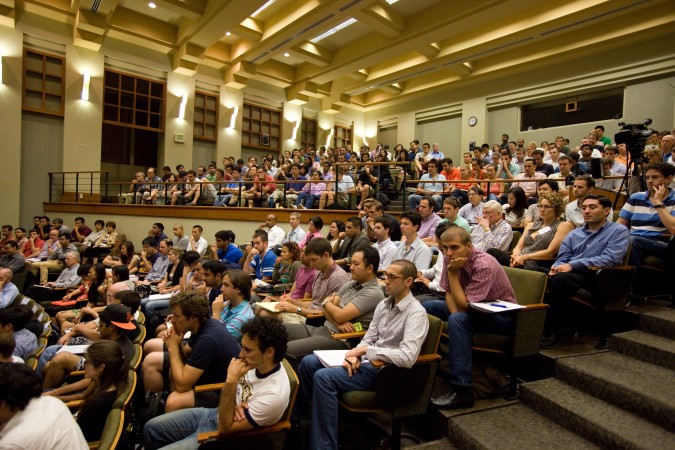
Audience watches Rich Lyons interview Intel CEO Paul Otellini, October 3, 2012 at University of California Berkeley, in Berkeley, California USA
When Otellini became CEO in 2005 he assessed that Intel was not organized correctly for where he saw the market heading. At the time, Intel had 105,000 employees. Otellini eliminated 25,000 jobs. The company is today back up to 103,000 employees. His advisers in 2005 were asking why he wanted to go into ‘the phone business’ when Intel was making money hand over fist at the time. Otelllini said he had many sleepless nights when he was contemplating letting 25,000 people go. He said he will never feel good about that, but he is grateful that he made the change well before the world financial collapse of 2008, so all the people let go were able to find jobs quickly.
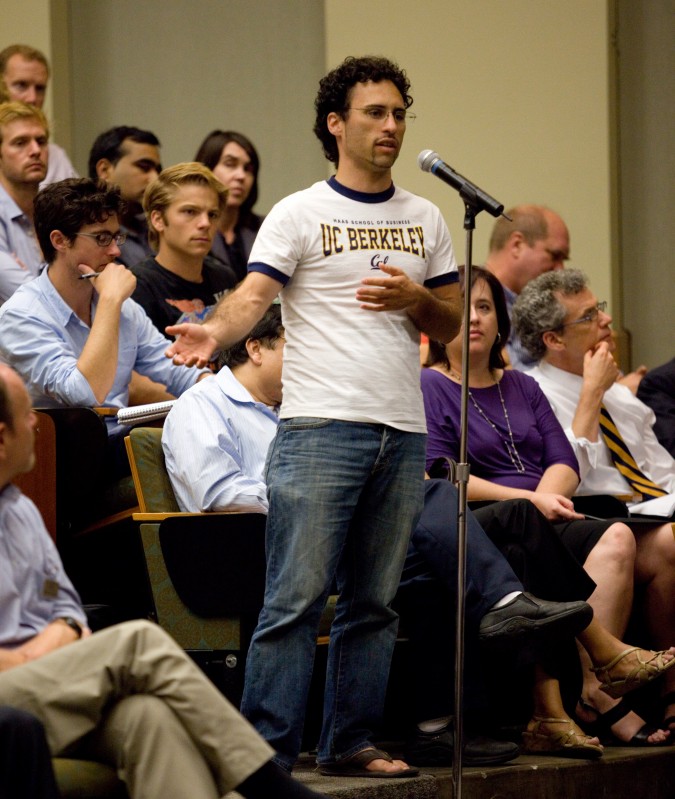
Second year Haas student Michael Vladimer asks Intel CEO Paul Otellini a question, October 3, 2012 at University of California Berkeley. To the right of the student, seated: Jill Erbland and Andre Marquis.
I was surprised to learn that Intel is the world’s 4th largest software company in the world based on the number of computer programmers that it employs.
Otellini advised to get work experience in different geographic locations prior to starting a family.
Otellini said its chips are manufactured in three dimensions, which was forced upon it by the laws of physics, which prevented circuits from being made much smaller. To keep making more capable chips, transistors had to be stacked as well as placed side by side. This technology took Intel 10 years to perfect, with thousands of PhD holders working on the effort.
I wonder if they considered adding a ‘Now in 3D!’ tagline to their famous ‘Intel Inside’ stickers.
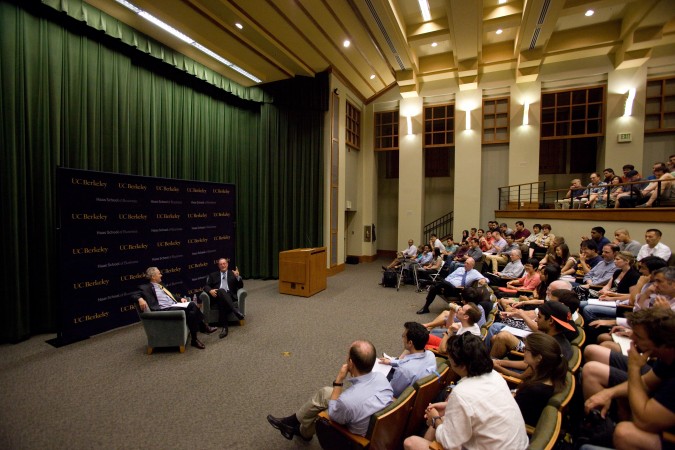
Audience watches Rich Lyons interview Intel CEO Paul Otellini, October 3, 2012 at University of California Berkeley
Otellini emphasized the high risks inherent in running Intel.
To illustrate, when Intel breaks ground on a new chip fabricating factory:
- the technology hasn’t been developed yet
- the products haven’t been designed yet
- the markets for the products don’t exist yet
These factories take 3 1/2 years to build and cost USD $5,500,000,000 each, and Intel starts construction on two or three of these per year.
That sounds like a great definition of high risk to me.
Intel makes hardware reference designs that it provides to its customers so that they can get products to market more rapidly. Otellini said personal computer makers don’t spend that much on industrial design, so they like and need Intel to provide these turn key designs they can modify to make them unique.
Otellini had a mentor at Berkeley while he was a student in the early 1970s. That mentor worked at Bank of America, and tried to get Otellini to join that bank. Several years after Otellini had joined Intel, his mentor confided that Otellini had chosen the right company.
Intel has put in place a system where they can identify the source of so-called conflict minerals. They can also track them, and Otellini said that Intel is likely to be able to say by January 2013 that Intel has built the world’s first ‘conflict mineral free microprocessor’.
Otellini said he had spoken in the morning with Robert Hormats, Under Secretary for Economic, Energy and Agricultural Affairs at the Department of State, who he said is very interested in [removing] conflict minerals from products. The Department of State, according to Otellini, wants to make Intel’s conflict mineral tracking system a so-called ‘best known method’ for the [semiconductor] industry.
Otellini said it recycles the chemicals used in its plants, and plans to recycle the water it uses to such a complete degree that its factories will be able to reuse the water they consume over and over, without needing to return it to the underground aquifers, like they do today.
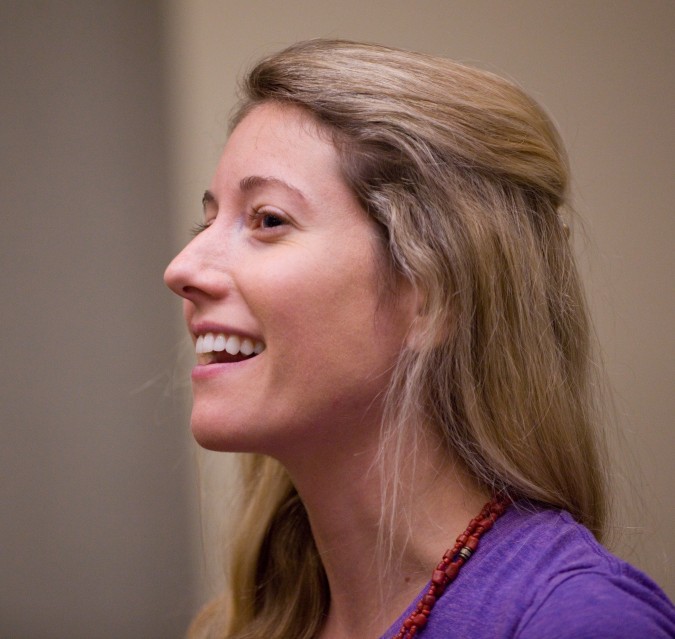
Audience member at Dean's Speaker Series with Paul Otellini at Haas School of Business, October 3, 2012.
Otellini spoke about manufacturing competitiveness generally in the United States, something he is qualified to speak about because he advises United States President Barack Obama about competitiveness.
He said many of the motivating factors that have led to outsourcing are disappearing. He said that it costs more for Intel to hire 1st and 2nd level technical managers in China now than it does in Santa Clara, California USA. For engineers with 3 or 4 years of experience, the costs to hire them are now the same in the US as they are in China and India.
Otellini said that the United States could improve its position by lowering its corporate tax rate [to a level consistent with the rate in competitive economies]. He suggested the US streamline its permitting procedures for building new factories. He suggested that job training be improved to provide a skilled workforce to work in the new factories. He pointed out that currency and political risks are low in the US, and stated there is no risk of a company’s factory being expropriated by the US government. In other countries, governments sometimes do take over privately owned factories.

Paul Otellini speaks with Arthur Gensler at University of California Berkeley, October 3, 2012. Photograph by Kevin Warnock.
There were some famous guests in the audience.
Perhaps the most famous attendee was Arthur Gensler, the founder of M. Arthur Gensler Jr. & Associates, Inc. but commonly referred to as simply Gensler. I have been aware of this global architecture, planning, design and consulting firm since I was 23 years old at my first job out of college, at Newell Color Laboratory at 630 Third Street in San Francisco, California USA, since closed. Gensler was an important client. I suspect Gensler may be helping to design the new building Dean Lyons is being planned for the Haas School of Business campus.

Arthur Gensler speaking with Paul Otellini, October 3, 2012 at Haas School of Business at University of California Berkeley
After the interview, Lyons pointed out Mr. Gensler to me — without his helpful comment, I would not have been able to write this acknowledgment of his visit. Gensler is a big deal — they employ 3,500 people in 42 locations. They count all 10 of the Fortune 500 top 10 companies as clients.
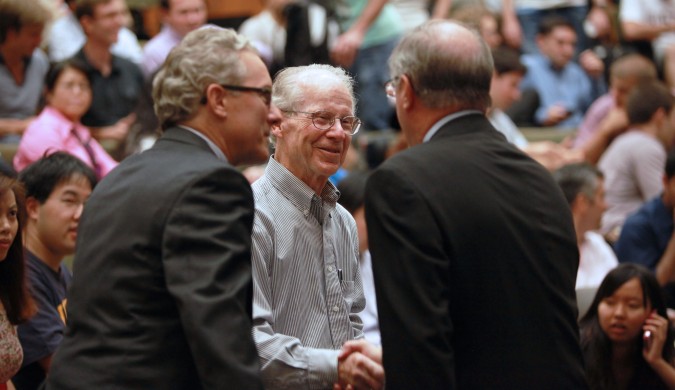
Haas School of Business Dean Rich Lyons, left, watches Haas Professor Emeritus and Nobel Prize winner Oliver Williamson shake hands with Intel CEO Paul Otellini at Haas School of Business at University of California Berkeley, October 3, 2012. Photograph by Kevin Warnock.
Perhaps the second most famous attendee was Oliver Williamson. Williamson is Professor Emeritus at the Haas School of Business. In 2009 Williamson won the Nobel Prize for Economics. I saw Williamson speak in 2009 at the Haas Gala, the annual party the school throws each November. I blogged about that gala and wrote about Williamson, who spoke at the event. I took a picture of Williamson shaking hands with Otellini, shown here.
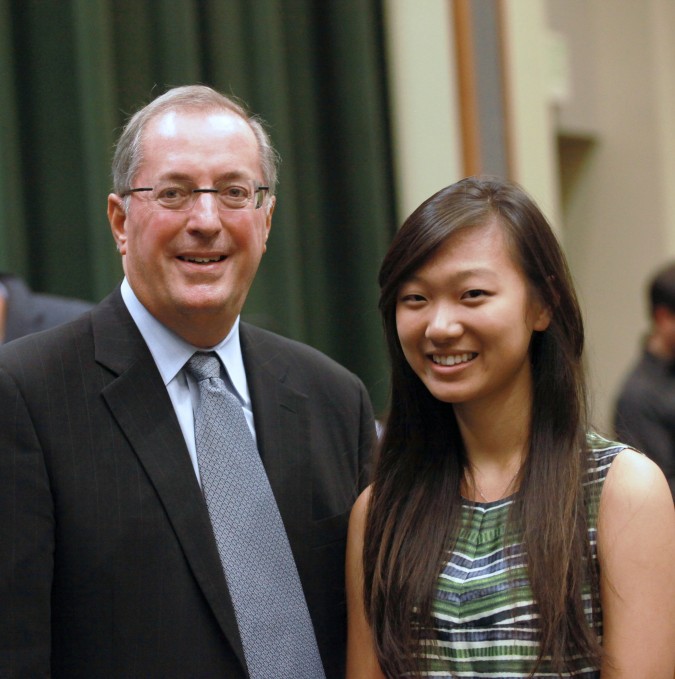
Intel CEO Paul Otellini with University of California Berkeley student Tammie Chen. Photograph by Kevin Warnock, October 3, 2012.
This last photograph of Mr. Otellini with Berkeley undergrad student Tammie Chen has an interesting story behind it.
I met Chen when she was an organizer for the 2011 Made for China Startup Pitch Competition. I was a judge for that competition. After that event, we became friends on Facebook, and she posted that she was going to be attending the Dean’s Speaker Series that is the subject of this blog post. I commented that I would be there as well, blogging. She asked me if I could take a picture of her with Otellini. I said I would. I walked up to him and asked him if I could introduce Chen to him and take a picture of him with her, and he readily agreed. They had a nice chat for a minute, and then they posed for this picture. Chen is a huge fan of Intel, and has visited their headquarters. She has a lot of friends that work at Intel.
I was surprised that no students approached Otellini to introduce themselves. This is the same behavior I saw at my first Dean’s Speaker Series event, in September 2012, when Lyons interviewed Randall Stephenson, the CEO of AT&T. There were students standing about 10 feet away from Otellini, in a large circle, but not a single student walked into the empty space to say hello. That made it easy for me to say hello to Mr. Otellini, who I have met and spoken with before, in 2008, at the Intel Capital CEO Summit [renamed the Intel Capital Global Summit] in San Francisco.
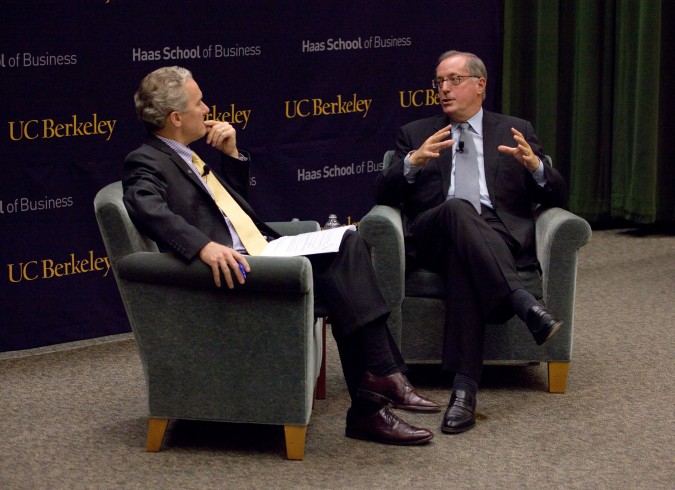
Haas School of Business Dean Rich Lyons and Intel CEO Paul Otellini, October 3, 2012 at University of California Berkeley. Photo by Kevin Warnock.
I like Intel. Their venture capital division Intel Capital was very nice to my company Silveroffice, Inc. by making it an Intel Capital Portfolio Company. Intel Capital invites me as their guest to Intel’s annual Intel Developer Forum, at which I get a new Intel Developer Forum branded laptop bag or backpack, which I use every time I leave my home with my Intel powered laptop. I hope to be appointed a judge for the Intel Global Challenge, a role I would be great at since I was a judge for the Berkeley Startup Competition for eight years through 2011. My application is pending, so please wish me luck! I love judging startup competitions, and so far I have judged four different competitions at University of California Berkeley.
I took all the photographs in this post. I used a Canon 5D Mark II camera with a Canon 80-200mm f:2.8 L zoom lens. Click on the images twice in delayed succession to see the images at full size. I uploaded the images at their full 21 megapixel resolution, at a JPG quality of 12. The light level was comparatively low, so I shot at ISO 2,500, without flash.
Thank you to Meg Fellner of the Dean’s Office for getting me a ticket to this sold out event.
